Physical Address
304 North Cardinal St.
Dorchester Center, MA 02124
In spite of improvement in designs and technique, prosthetic failure remains a problem that may be solved with relative ease or may require extensive reconstruction techniques. The more challenging problems involve periprosthetic fracture and osseous deficiency and are covered in detail in Chapter 107, Chapter 108, Chapter 109 . The general problems of reimplantation for failed elbow arthroplasty are placed in perspective of alternate salvage options (see Chapter 115, Chapter 119, Chapter 120 ). In this chapter, we deal with failed total elbow arthroplasty (TEA) with adequate osseous integrity allowing a direct reimplantation and cementation.
There are several ways of categorizing failed prior arthroplasty, each with different implications for treatment ( Table 106.1 ).
| Index Arthroplasty | Osseous Integrity | Revision Options |
|---|---|---|
| Resection | Variably deficient humerus and/or ulna metaphysis | Insert into mature? bone; may require long flange |
| Fusion | Adequate | Treat as primary arthroplasty |
| Interposition | Adequate | Treat as primary arthroplasty |
| Implant failure |
|
a Strut and impaction grafting may be combined in some procedures.
Failure of a nonimplantation procedure such as interposition is discussed in Chapter 96 ; revision for sepsis is discussed in Chapter 101 . Management for osseous deficiencies is covered in the next three chapters.
This is mentioned here to emphasize the difficulty of making the diagnosis in some instances. The topic is covered in detail in Chapter 100 . A high index of suspicion must be developed. The combination of a sedimentation rate over 23 mm/h and a CRP in excess of 13.5 mg/L has been shown to correlate with infection with a specificity and sensitivity of 85% and 90%, respectively. More recently, the screening test using alpha-defensin (Synovasure, Zimmer, Warsaw, IN) appears very promising, with specificity and sensitivity both in excess of 90%. Infection of a well-fixed device is particularly bothersome, because removing the prosthesis may result in fracture that poses major reconstructive problems. For this reason, today we attempt débridement as a definitive treatment in this setting.
With improved fixation techniques, articular wear has become one of the most common modes of failure of the Coonrad-Morrey device although this does not tend to lead to component loosening. Because the semiconstrained implant is being used for broader indications and loosening is much less of a problem, articular wear is increasingly being recognized over long-term follow-up. The topic is reviewed in detail in Chapter 104 . Importantly, extensive osteolysis has been confused as a complication of bushing wear and is now known to be primarily related to the loosening of the precoat ulnar component, a design that has not been used for more than 15 years.
Fracture of prosthetic stems is uncommon today and usually follows excessive activity or single event trauma ( Fig. 106.1 ). Athwal et al. reviewed the Mayo experience with fractured components. The technique of removing well-fixed stems and reinsertion into an expansion of the cement mantle was successful in about 80% of patients.
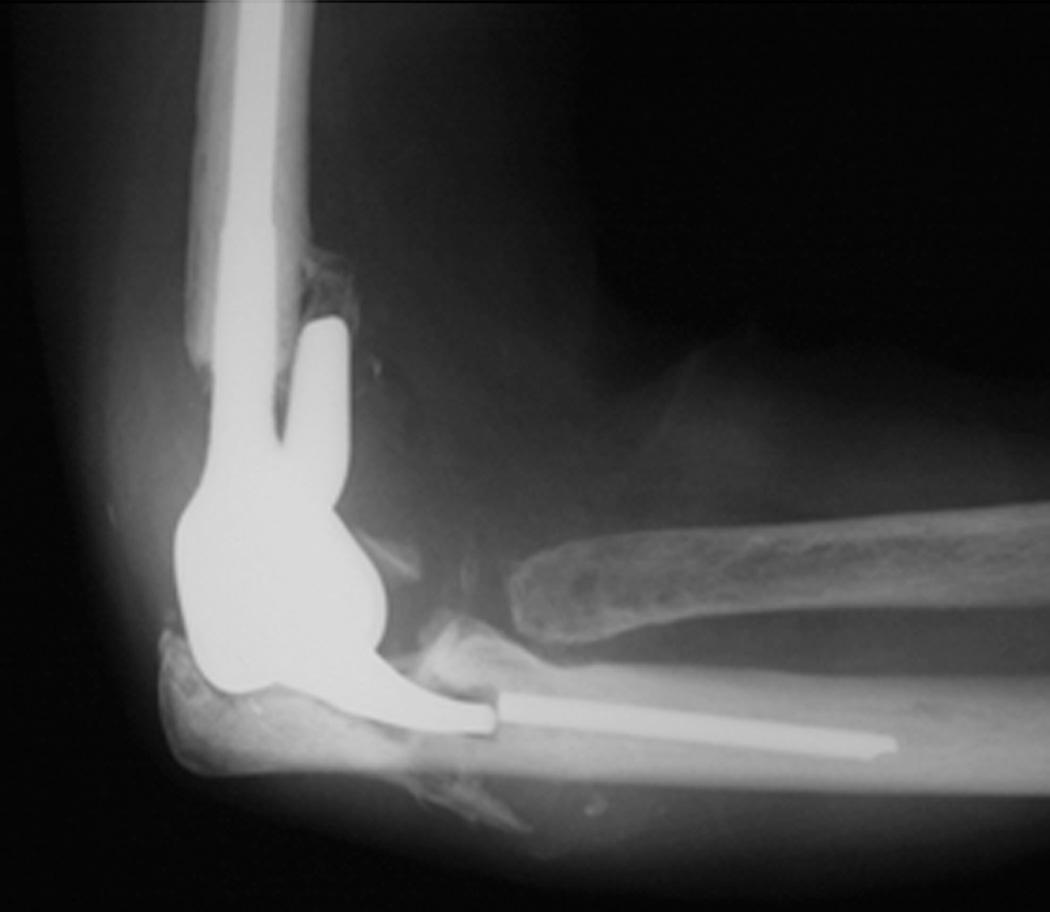
Unstable joints can usually be revised with maintenance of osseous integrity and thus are amenable to reimplantation into host bone without osseous augmentation. The topic is covered in detail in Chapter 105 . It is seen with unlinked implants and is associated with excessive activity, improper initial balance, or implant wear.
The diagnosis is usually obvious, but in questionable cases, examination under fluoroscopy may be helpful ( Fig. 106.2 ).

While used less commonly today, the selection of unlinked implant has been predicated to some extent on the assumption that a revision would be more reliable after this type of design. In fact, a review of Mayo's 30-year experience with linked and unlinked implants appears to confirm this assumption if the revision was to a linked device ( Fig. 106.3 ). Unfortunately, it was also demonstrated that the need to revise the unlinked implant occurred at a significantly greater frequency than did the need to reoperate on a linked device ( Fig. 106.4 ).
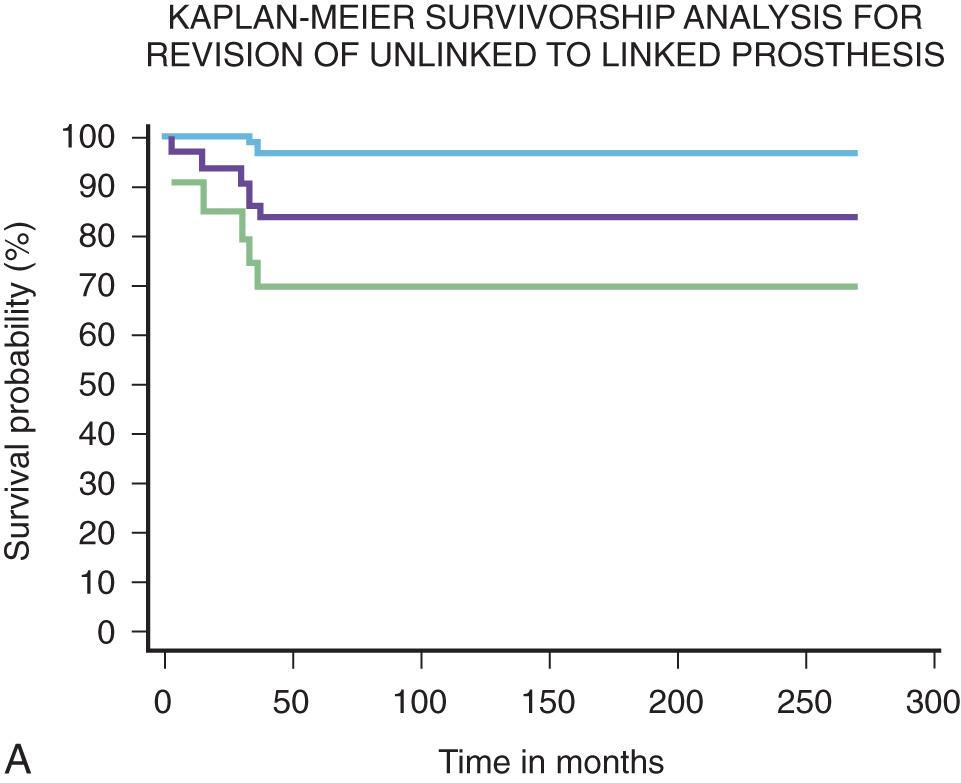
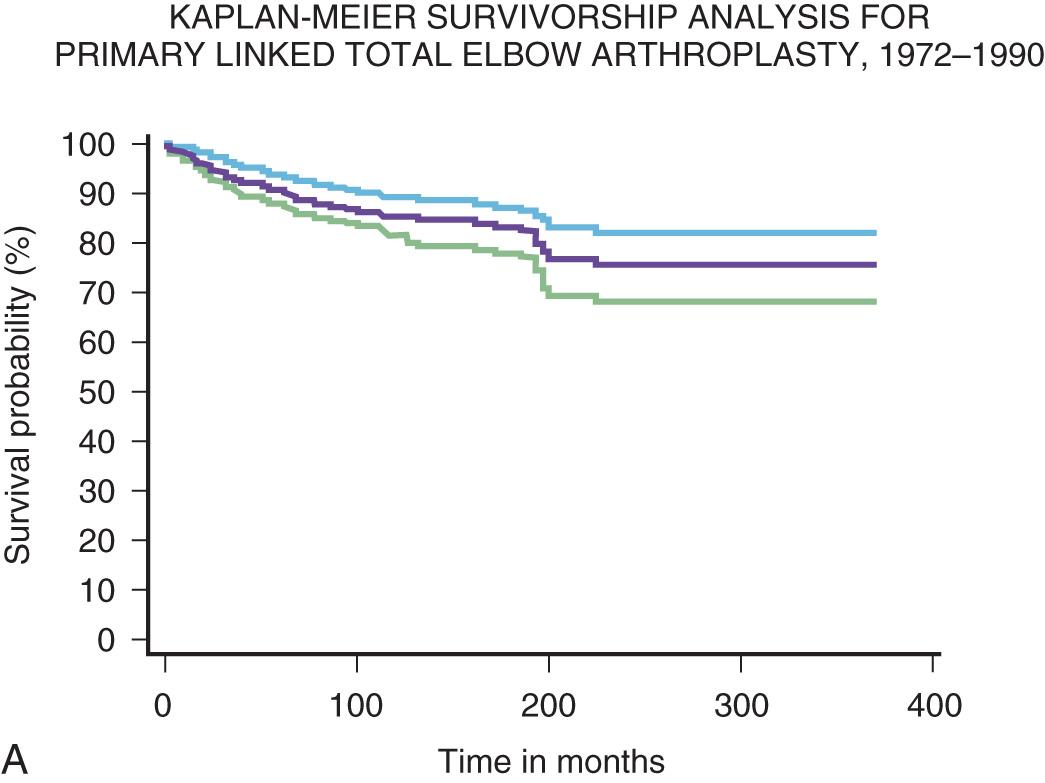
If detected early, a loose implant may be revised with reimplantation into host bone. Loosening occurs roughly equally at the ulna or at the humerus, depending on the design. The key to successful treatment is the quality of the osseous structure. We have identified several features of the host bone and correlated the effectiveness of reimplantation ( Fig. 106.5 ). As might be expected, the most effective reimplantations were in those with better quality bone stock or those in whom osseous deficiency was addressed at the time of reimplantation.
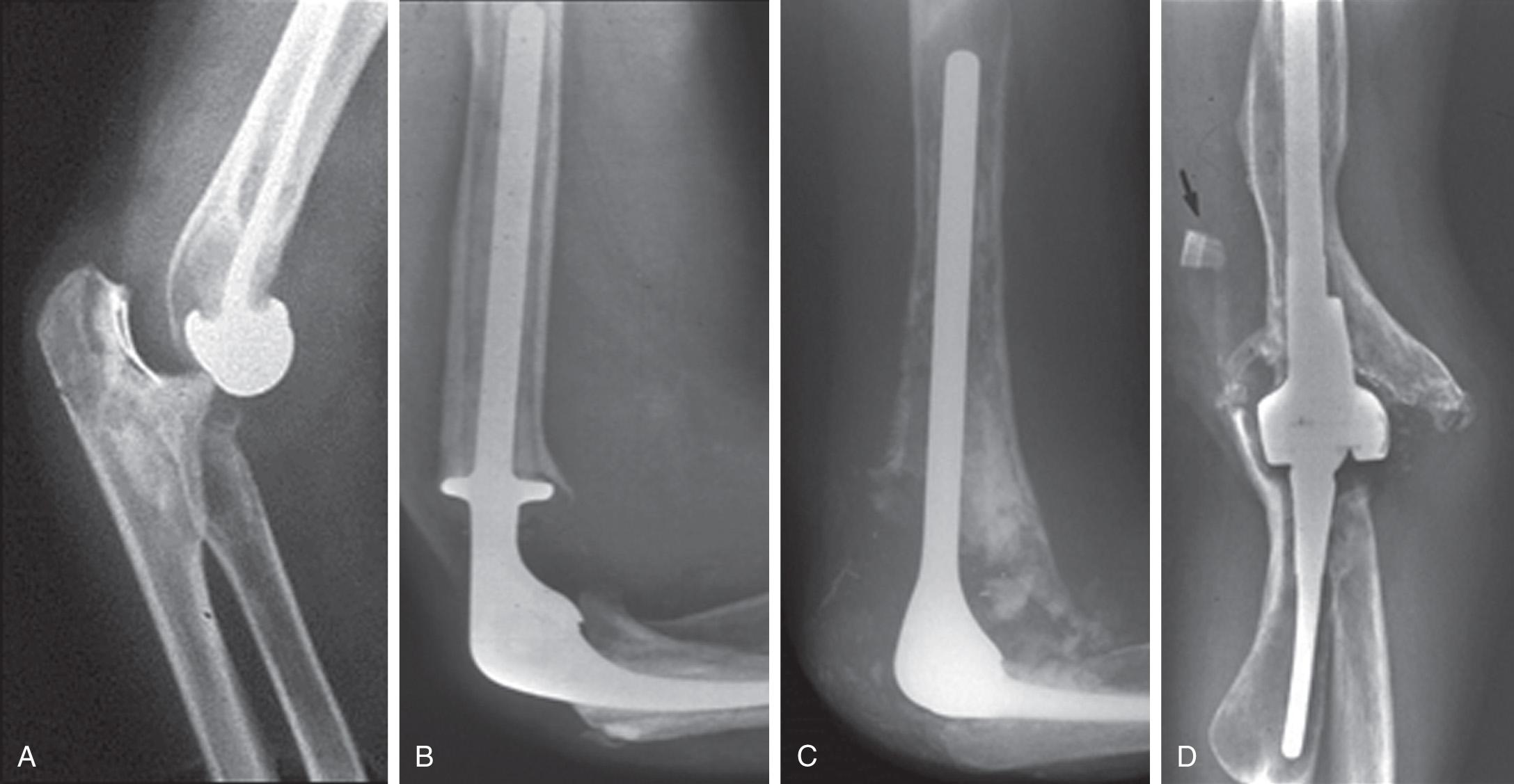
Different clinical expressions of failure are recognized, and both reimplantation and nonreimplantation options depend primarily on the amount of bone present ( Table 106.2 ). Pain is typically but not universally present. Further, a loose implant may cause pain but few or no x-ray changes ( Fig. 106.6 ). Conversely, gross instability and loosening may present with minimal or no pain. Once a stem loosens, cortical thinning or “ballooning” of the humerus or the ulna may occur, albeit silently. Such may pose major problems with the reconstructive procedure, especially when the bone loss is complicated by fracture, which can sometimes be “silent” ( Fig. 106.7 ). The topic of periprosthetic fracture is reviewed in detail in Chapter 103 .
| Bone Stock | Options |
|---|---|
| Adequate | Arthrodesis, resection, interposition, TEA, semiconstrained prosthesis |
| Inadequate | Resection, allograft, TEA, semiconstrained (long-flanged) prosthesis composite (TEA with allograft), custom-made prosthesis |
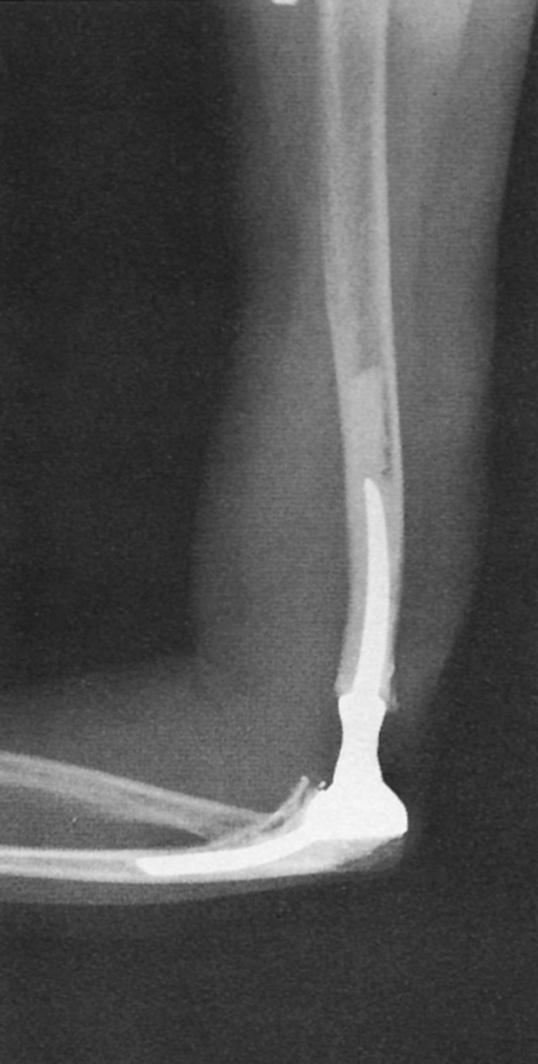
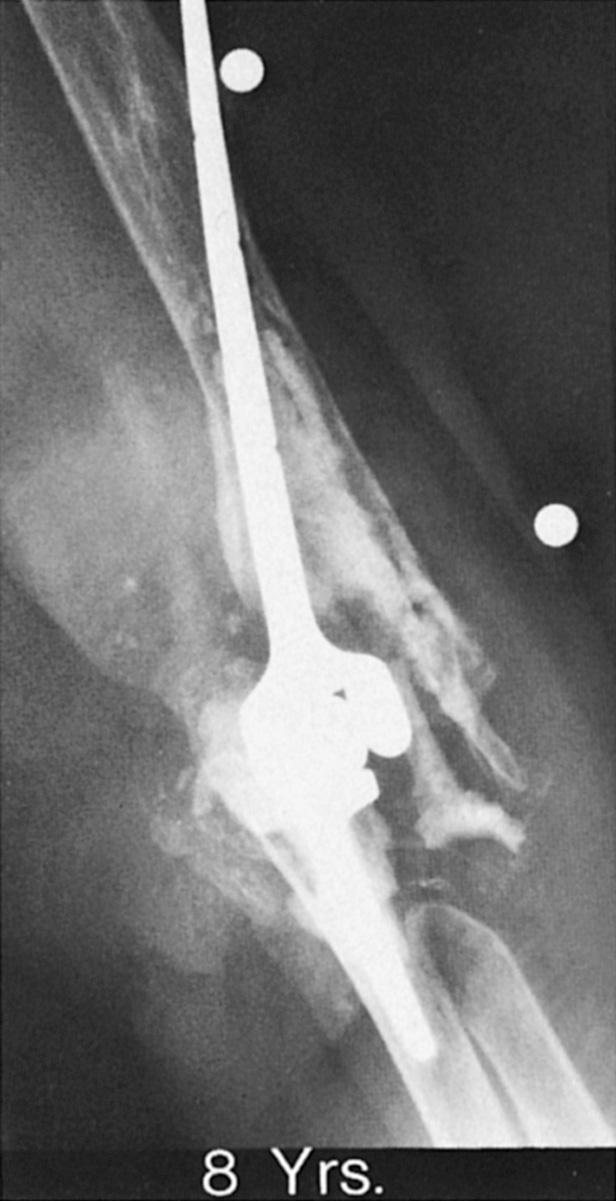
Revision strategies can be predicated according to the characteristics of the failure mode. It is important to assess and avoid the cause of failure; do something different or differently. We have found the thought process used for failed femoral components after total hip replacement to be helpful in this regard. In addition to age, diagnosis, and anticipated level of activity, the factors that determine strategy include:
Humeral: (1) presence of distal humerus referable to the olecranon fossa; (2) quality of periprosthetic bone; (3) presence and location of any fracture; (4) presence of shoulder pathology possibly requiring replacement.
Ulnar: (1) presence of olecranon; (2) quality of periprosthetic bone; (3) presence and location of fracture.
Furthermore, as noted, the revision must overcome the shortcomings of the first prosthesis or technique and the biological response to the loose implant. This usually requires a stem that bypasses any cortical weakness or fracture, provisions for adequate distal humeral or ulnar fixation, and a reliable articulation. Unless measures are taken to address these considerations, reimplantation will not be successful on a regular basis. It must be reemphasized that if reimplantation is to be considered a viable option, the mechanical or biologic causes of the initial failure must be addressed and solved by the new design and technique.
Become a Clinical Tree membership for Full access and enjoy Unlimited articles
If you are a member. Log in here